Hawaii’s vibrant coral reefs are home to a diverse array of tropical fish, showcasing the islands’ unique marine biodiversity and the ecological importance of reef ecosystems.
1.1 Overview of Hawaii’s Marine Biodiversity
Hawaii’s marine environment is renowned for its exceptional biodiversity, with coral reefs teeming with vibrant tropical fish, sea turtles, and colorful invertebrates. The islands’ geographic isolation has fostered unique species, many found nowhere else on Earth. From parrotfish to butterflyfish, angelfish, and rare endemic species, Hawaii’s reefs support over 400 species of fish. This rich ecosystem attracts scientists, divers, and enthusiasts, making it a global hotspot for marine exploration and conservation efforts.
1.2 Importance of Reef Fish in Hawaiian Ecosystems
Reef fish play a vital role in maintaining the balance of Hawaii’s marine ecosystems. They contribute to coral reef health by controlling algae growth and maintaining biodiversity. As key players in the food chain, they link primary producers to higher predators, ensuring ecosystem stability. Additionally, reef fish are central to Hawaii’s economy and culture, supporting commercial fisheries, tourism, and traditional practices. Their loss could disrupt the entire ecosystem and impact human livelihoods dependent on these resources.
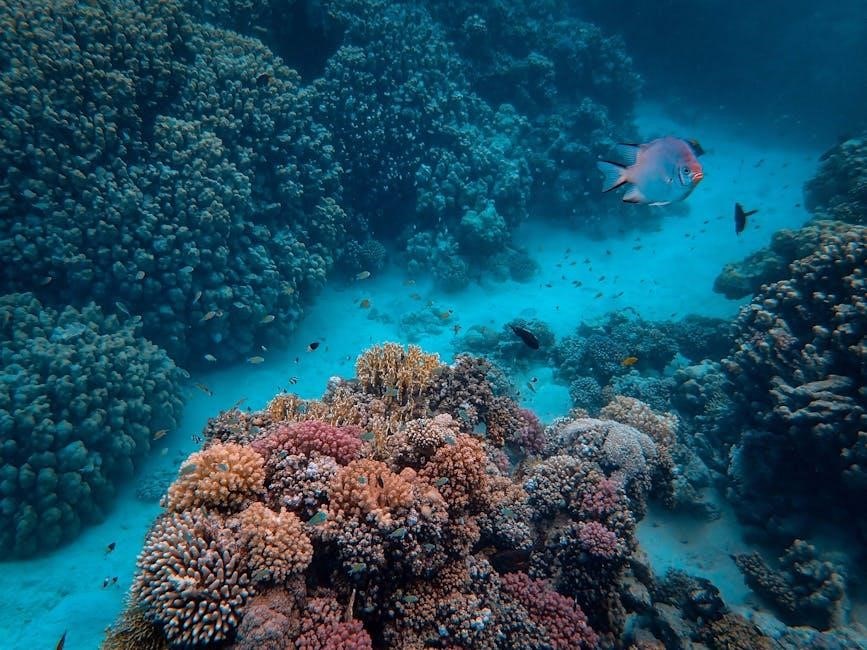
Popular Species of Hawaiian Reef Fish
Hawaii’s reefs are renowned for vibrant species like parrotfish, butterflyfish, and angelfish, each adding color and complexity to the underwater environment. These fish are vital to marine ecosystems.
2.1 Iconic Fish: Parrotfish, Butterflyfish, and Angelfish
Parrotfish, with their vibrant scales and distinctive teeth, play a crucial role in coral health by grazing algae. Butterflyfish, known for their striking patterns, often form pairs and feed on coral polyps. Angelfish, recognizable by their flowing fins, add elegance to Hawaii’s reefs. These iconic species are not only visually stunning but also vital to maintaining the balance of marine ecosystems, making them favorites among divers and snorkelers exploring Hawaiian waters.
2.2 Rare and Unique Species Found in Hawaiian Waters
Hawaii’s oceans host rare species like the masked angelfish, found only in deep waters, and the Hawaiian cardinalfish, known for its striking patterns. The potter’s angelfish, a endemic species, is rarely seen by divers. These unique fish, often small or elusive, contribute to the reef’s biodiversity and attract marine enthusiasts. Their scarcity underscores the importance of conservation efforts to protect these irreplaceable components of Hawaii’s underwater world.
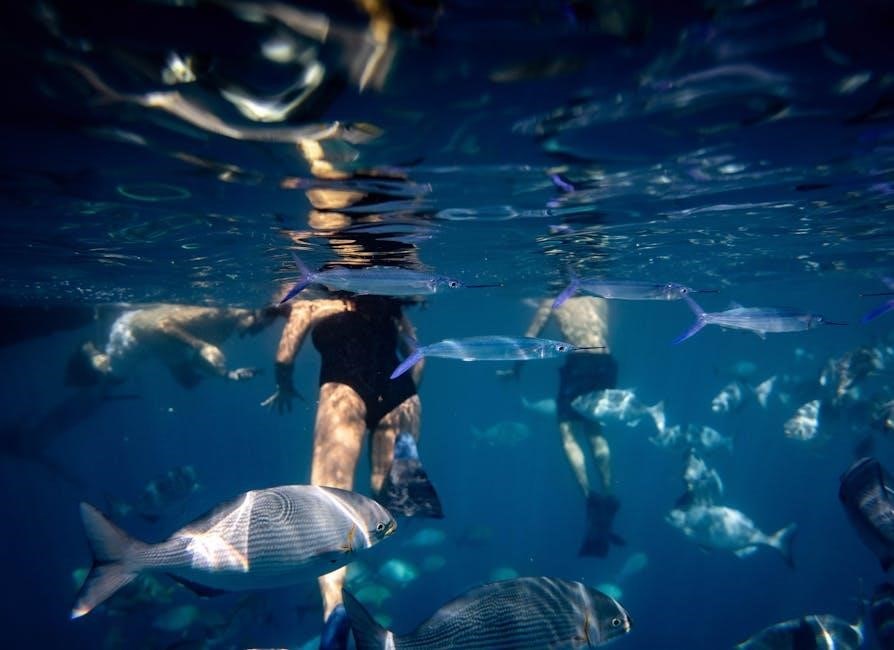
Conservation Efforts for Hawaiian Reef Fish
Hawaii’s conservation efforts focus on protecting reef fish habitats, enforcing marine protected areas, and combating invasive species to preserve biodiversity and ensure ecosystem health.
3.1 Protected Species and Regulations
Hawaii has implemented strict regulations to protect its reef fish populations. Several species, including parrotfish and butterflyfish, are safeguarded under state and federal laws. Marine protected areas and no-take zones are enforced to ensure the sustainability of these species. The Hawaii Department of Land and Natural Resources (DLNR) plays a key role in monitoring and enforcing these regulations. These measures are crucial for maintaining healthy reef ecosystems and biodiversity in Hawaiian waters.
3.2 Impact of the Aquarium Trade on Reef Fish Populations
The aquarium trade significantly impacts Hawaiian reef fish populations, particularly species like Yellow Tangs, which are highly sought after. Despite regulations, overcollection has led to population declines and habitat degradation. The trade also disrupts reef ecosystems, as removing key species affects balance. Poor care in captivity often results in fish mortality, further highlighting ethical concerns. Conservation efforts aim to mitigate these impacts while ensuring sustainable practices in the aquarium industry.
Best Spots for Snorkeling and Diving
Hawaii offers renowned snorkeling and diving spots, including Hanauma Bay, Molokini Crater, and Kealakekua Bay, known for clear waters, vibrant coral, and diverse marine life.
4.1 Hanauma Bay: A Premier Spot for Reef Fish Exploration
Hanauma Bay, a protected marine sanctuary, offers exceptional snorkeling and diving experiences. Its clear, turquoise waters teem with colorful fish like parrotfish, butterflyfish, and angelfish. The bay’s vibrant coral reefs and diverse marine life attract visitors worldwide. As a conservation area, it ensures the preservation of Hawaii’s unique ecosystem. This spot is ideal for both beginners and experienced divers, providing an unforgettable opportunity to explore tropical marine biodiversity up close.
4.2 Other Key Locations for Observing Reef Fish
Beyond Hanauma Bay, Hawaii offers numerous exceptional spots for reef fish exploration. Molokini Crater, a submerged volcanic crater off Maui, boasts crystal-clear waters teeming with tropical fish. Kealakekua Bay on the Big Island, a marine sanctuary, features vibrant reefs and diverse species. Kauai’s Poipu Beach and Na Pali Coast provide stunning snorkeling opportunities, with colorful fish and coral formations. These locations offer unforgettable experiences for both novice and experienced marine enthusiasts.
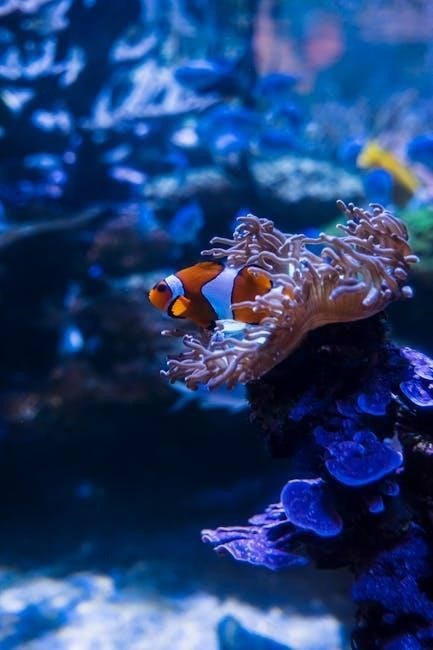
Tips for Identifying Hawaiian Reef Fish
Observe shape, color, and behavior to identify species. Use detailed field guides or apps for accurate recognition. Note unique markings and fins for precise identification.
5.1 Using Fish ID Cards and Guides
Fish ID cards and guides are essential tools for identifying Hawaiian reef fish. These laminated, waterproof cards feature detailed images and descriptions of common species. They can be used underwater, making them ideal for snorkelers and divers. Field guides like The Ultimate Guide to Hawaiian Reef Fishes provide comprehensive information, including high-quality photos and scientific descriptions. By comparing observed traits with guide details, enthusiasts can accurately identify species, enhancing their appreciation of Hawaii’s marine diversity.
5.2 Key Characteristics for Accurate Identification
Accurate identification of Hawaiian reef fish relies on observing key characteristics such as fin shape, color patterns, and body markings. Distinctive features like vibrant hues, stripes, or spots help differentiate species. For example, parrotfish are recognized by their bright scales, while butterflyfish often display striking spotted patterns. Size, tail shape, and behavior also provide critical clues. By focusing on these traits and using detailed guides, enthusiasts can confidently identify species and deepen their understanding of Hawaii’s marine life.
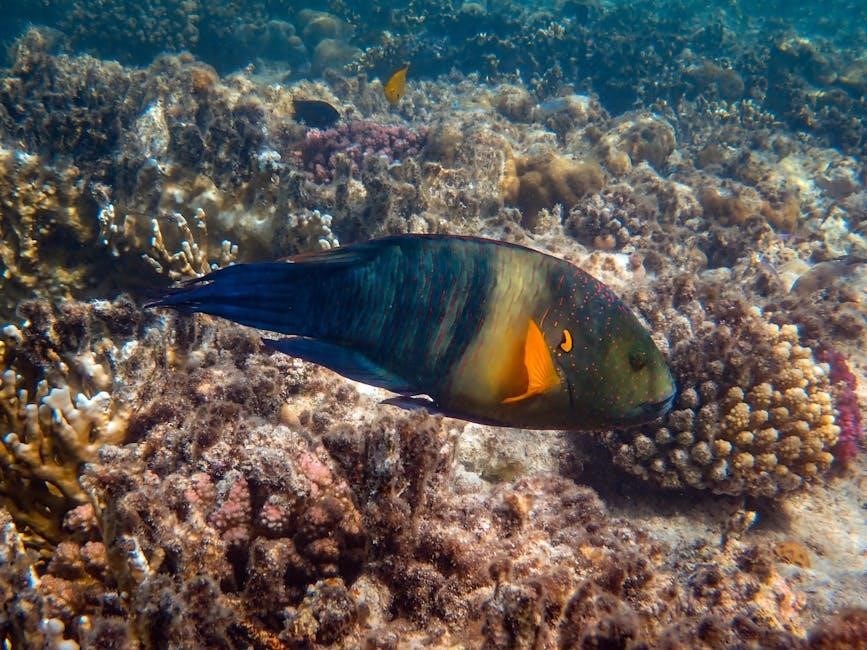
Cultural Significance of Reef Fish in Hawaii
Hawaiian reef fish hold deep cultural significance, featuring prominently in traditional legends, art, and daily life. They symbolize spiritual connections and historical reliance on marine resources for sustenance and ceremonies.
6.1 Traditional Hawaiian Uses of Reef Fish
In traditional Hawaiian culture, reef fish were integral to daily life, serving as a primary food source and featuring in ceremonial practices. Various species were harvested sustainably, guided by the kapu system, which ensured resource conservation. Fish were also used in cultural rituals and as offerings to deities. Additionally, their bones and shells were crafted into tools and ornaments, reflecting their multifaceted role in Hawaiian society and identity.
6.2 Reef Fish in Hawaiian Legends and Art
Hawaiian reef fish are central to ancient myths, often symbolizing strength, wisdom, and spirituality. In legends, they are associated with deities like Kanaloa, god of the ocean. Traditional Hawaiian art, such as intricate koa wood carvings and tattoos, frequently depict reef fish, highlighting their cultural significance; These artistic expressions reflect a deep connection to the sea and its creatures, preserving the islands’ rich storytelling heritage and the reverence for marine life in Hawaiian identity.
Sustainable Tourism Practices
Responsible snorkeling and diving practices, such as avoiding coral contact, are vital to preserving Hawaii’s reef ecosystems. Supporting eco-friendly tour operators fosters conservation and educates visitors.
7.1 Responsible Snorkeling and Diving Practices
Responsible snorkeling and diving practices are essential to protect Hawaii’s delicate reef ecosystems. Avoid touching or standing on corals, as this can cause irreversible damage. Refrain from feeding fish, as it disrupts their natural behavior. Use reef-safe sunscreen to prevent chemical harm to marine life. Always maintain a safe distance from marine creatures and avoid wearing gloves or fins that might accidentally harm the reefs. Stay horizontal in the water to minimize sediment disturbance and ensure gear is securely fastened to prevent accidental contact with the reef. By adhering to these guidelines, visitors can help preserve Hawaii’s underwater beauty for future generations.
7.2 Supporting Eco-Friendly Tour Operators
Supporting eco-friendly tour operators is crucial for preserving Hawaii’s marine ecosystems. Choose operators that adhere to sustainable practices, such as using eco-friendly gear and promoting reef-safe behaviors. Many operators provide educated guides who emphasize marine conservation and respect for wildlife. By supporting these businesses, you contribute to the protection of Hawaii’s reef ecosystems and promote responsible tourism. This approach ensures a positive impact on both the environment and local communities.
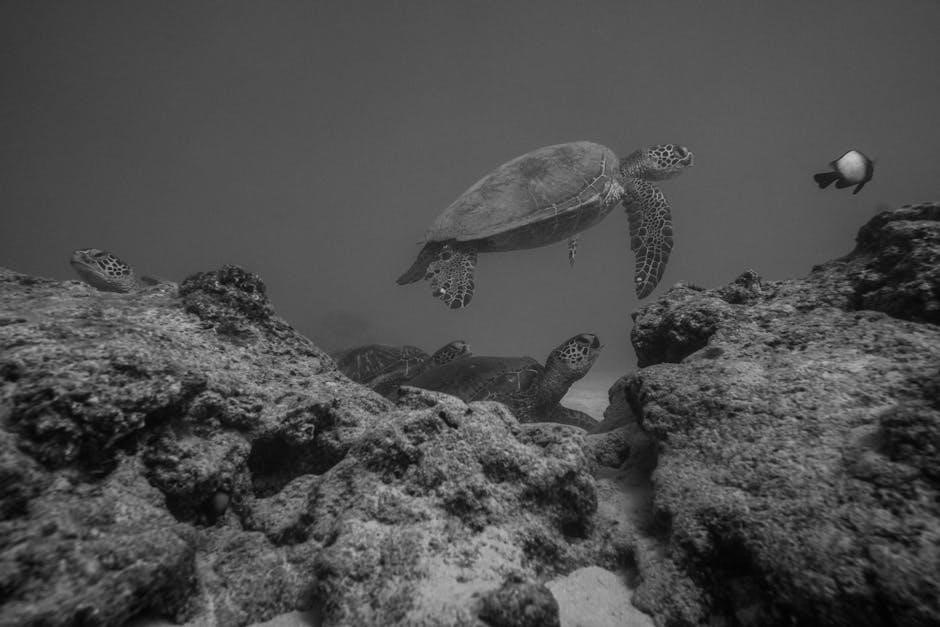
Threats to Hawaiian Reef Fish
Hawaiian reef fish face significant threats from climate change, invasive species, and pollution, which degrade habitats and disrupt marine ecosystems, endangering their survival and biodiversity.
8.1 Climate Change and Coral Bleaching
Rising sea temperatures and ocean acidification due to climate change severely impact Hawaiian coral reefs, causing bleaching and reducing habitat diversity. This stress weakens corals, making them vulnerable to disease and reducing their ability to support reef fish. As corals die, the intricate ecosystems they sustain collapse, leaving fish without food or shelter. This cascade threatens the survival of many species, highlighting the urgent need for climate action to protect these vital marine ecosystems and their inhabitants.
8.2 Invasive Species and Pollution
Invasive species, such as lionfish and algae, disrupt Hawaii’s reef ecosystems by outcompeting native fish and degrading habitats. Pollution from land-based runoff and marine debris further threatens reef health, damaging fish habitats and affecting their survival. These combined pressures exacerbate ecosystem stress, making conservation efforts critical to preserving biodiversity and ensuring the long-term health of Hawaii’s coral reefs and their inhabitants.
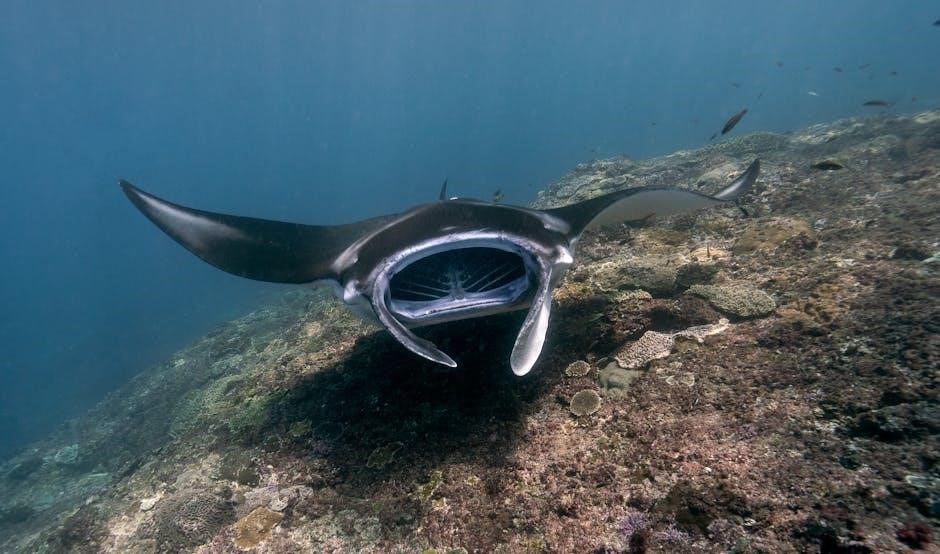
Scientific Research and Monitoring
Scientific research and monitoring play a crucial role in conserving Hawaii’s reef fish populations. Ongoing studies and technological advancements help track marine health and inform sustainable practices.
9.1 Ongoing Studies on Reef Fish Populations
Scientists monitor Hawaii’s reef fish populations to understand their health and trends. Research focuses on species diversity, habitat use, and impacts from environmental changes, including coral cover and water quality. These studies aim to protect marine biodiversity and ensure ecological balance. By tracking population dynamics, researchers can identify threats and support conservation efforts, aiding in the preservation of Hawaii’s vibrant reef ecosystems.
9.2 Technological Advances in Marine Conservation
Technological advancements are revolutionizing marine conservation in Hawaii. Underwater drones and AI-powered sensors monitor reef fish populations and detect illegal fishing. Satellite imaging tracks coral health, while acoustic devices study fish behavior. These tools enable real-time data collection, aiding in informed conservation decisions. Additionally, underwater robots assist in coral restoration, and citizen science apps engage the public in reef monitoring, fostering a collaborative approach to marine preservation.
10.1 The Future of Hawaii’s Reef Fish
The future of Hawaii’s reef fish hinges on addressing climate change, invasive species, and pollution. Conservation efforts, sustainable tourism, and community engagement are critical to preserving biodiversity. Protecting coral reefs and enforcing regulations will ensure these species thrive. Ongoing research and education are vital to safeguarding marine life for future generations. Collective action is necessary to mitigate threats and maintain the balance of Hawaii’s vibrant marine ecosystems.
10.2 Call to Action for Conservation
Protecting Hawaii’s reef fish requires immediate action. Support conservation organizations, spread awareness, and advocate for sustainable practices. Choose eco-friendly tour operators and practice responsible snorkeling and diving. Avoid touching reefs and never feed fish. Make informed choices to reduce plastic use and carbon emissions. Together, we can safeguard Hawaii’s marine biodiversity for future generations. Every small effort contributes to preserving these vibrant ecosystems.